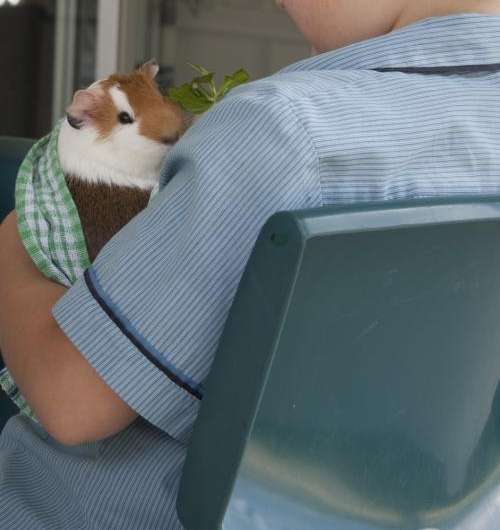Children with autism show increased positive social behaviors when animals are present

The presence of an animal can significantly increase positive social behaviors in children with autism spectrum disorders (ASD), according to research published February 20 in the open access journal PLOS ONE by Marguerite E O'Haire and colleagues from the University of Queensland, Australia.
The authors compared how 5-13 year old children with ASD interacted with adults and typically-developing peers in the presence of two guinea pigs compared to toys. They found that in the presence of animals, children with ASD demonstrated more social behaviors like talking, looking at faces and making physical contact. They were also more receptive to social advances from their peers in the presence of the animals than they were when playing with toys. The presence of animals also increased instances of smiling and laughing, and reduced frowning, whining and crying behaviors in children with ASD more than having toys did.
Previous studies have shown that people are more likely to receive overtures of friendship from strangers when walking a dog than when walking alone, and similar effects have been observed for people holding smaller animals like rabbits or turtles. The authors suggest that this 'social lubricant' effect of animals on human social interactions can be particularly important for individuals with socio-emotional disabilities.
According to the authors, the ability of an animal to help children with ASD connect to adults may help foster interactions with therapists, teachers or other adult figures. They add that animal-assisted interventions may have applications in the classroom as well, saying "For children with ASD, the school classroom can be a stressful and overwhelming environment due to social challenges and peer victimization. If an animal can reduce this stress or artificially change children's perception of the classroom and its occupants, then a child with ASD may feel more at ease and open to social approach behaviors."
More information: O'Haire ME, McKenzie SJ, Beck AM, Slaughter V (2013) Social Behaviors Increase in Children with Autism in the Presence of Animals Compared to Toys. PLoS ONE 8(2): e57010. doi:10.1371/journal.pone.0057010















